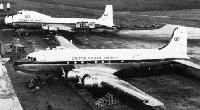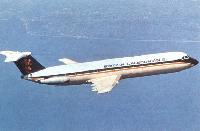Фотографии
-
Регистрационный номер: G-AXRS For the forthcoming scheduled transatlantic service, British Caledonian Airways will be using Boeing 707-320Cs such as G-AXRS County of Caithness.
Самолёты на фотографии: Boeing Boeing 707/720 - США - 1954
-
The one of three aircraft types that go to make up the British Caledonian fleet in 1972 are shown in the current livery. The Boeing 707 fleet has exclusively Caledonian origins.
Самолёты на фотографии: Boeing Boeing 707/720 - США - 1954
-
Регистрационный номер: G-AHCV The venerable Douglas DC-3 played a vital part in the formative years of several of British Caledonian's predecessor companies, including Morton Air Services, whose G-AHCV shown here had previously been part of the BEA fleet.
Самолёты на фотографии: Douglas DC-3 / C-47 Skytrain/С-53 Skytrooper / Dakota - США - 1935
-
Регистрационный номер: G-ANEG A Douglas DC-3, G-ANEG, in the markings of Transair.
Самолёты на фотографии: Douglas DC-3 / C-47 Skytrain/С-53 Skytrooper / Dakota - США - 1935
-
Регистрационный номер: G-AOFW Following the Hunting-Clan Airwork merger, the BUA fleet went through a number of livery changes. In this picture a former Air Charter C-54, G-AOFW Jason, is seen in British United Airways colours with a Channel Air Bridge Carvair beyond.
Самолёты на фотографии: Aviation Traders ATL.98 Carvair - Великобритания - 1961Douglas DC-4 / C-54 / R5D Skymaster - США - 1942
-
Регистрационный номер: G-AMWC The Bristol Freighters of Silver City, such as this Mk 32 G-AMWC City of Durham were later absorbed into the BUA fleet and then separated out to be used by the British Air Ferries division, which was not involved in the Caledonian take-over.
Самолёты на фотографии: Bristol Freighter / Type 170 - Великобритания - 1945
-
One of the four BUA VC 10s in pre-merger colours, with the name and flag of BUA's subsidiary Sierra Leone Airways also incorporated in the livery.
Самолёты на фотографии: Vickers VC-10 - Великобритания - 1962
-
Регистрационный номер: G-ATDJ The one of three aircraft types that go to make up the British Caledonian fleet in 1972 are shown in the current livery. The four VC 10s were originally part of the BUA fleet and G-ATDJ was built initially for Ghana Airways before being acquired by BUA.
Самолёты на фотографии: Vickers VC-10 - Великобритания - 1962
-
Регистрационный номер: G-ANRT One of the three Vickers Viscount 732s acquired by Hunting-Clan but used only briefly by that company in own colors.
Самолёты на фотографии: Vickers Viscount - Великобритания - 1948
-
Регистрационный номер: G-ASHL [2] One of the Douglas DC-7s leased by Caledonian from Sabena, G-ASHL, and used primarily for long-distance charter flights, including many transatlantic journeys.
Самолёты на фотографии: Douglas DC-7 - США - 1953
-
Регистрационный номер: G-ASHL [2] The first aircraft operated by Caledonian Airways over the North Atlantic were DC-7Cs leased from Sabena, such as G-ASHL (originally OO-SFK).
Самолёты на фотографии: Douglas DC-7 - США - 1953
-
Регистрационный номер: G-AWYS The BAC One-Eleven 500 G-AWYS Isle of Bute in the interim Caledonian//BUA markings used immediately after the take-over.
Самолёты на фотографии: BAC BAC.111 One-Eleven - Великобритания - 1963
-
The one of three aircraft types that go to make up the British Caledonian fleet in 1972 are shown in the current livery. BAC One-Eleven in the British Caledonian fleet include examples originally purchased both by BUA and by Caledonian Airways.
Самолёты на фотографии: BAC BAC.111 One-Eleven - Великобритания - 1963
-
Регистрационный номер: G-ARSD Like the Bristol Freighter, the Aviation Traders Carvairs such as G-ARSD Chelsea Bridge, were used in BUA livery for a time before going to British Air Ferries.
Самолёты на фотографии: Aviation Traders ATL.98 Carvair - Великобритания - 1961
-
Регистрационный номер: G-APNA Britannias have been operated in the liveries of many of the airlines which are now part of the history of British Caledonian. Illustrated are the markings of BUA's parent company, British and Commonwealth Shipping Co Ltd, on Britannia 317 G-APNA.
Самолёты на фотографии: Bristol Britannia / Type 175 - Великобритания - 1952
-
Регистрационный номер: G-AOGO Morton Air Services, eventually acquired by BUA, operated de Havilland Herons such as G-AOGO on short routes from the UK.
Самолёты на фотографии: De Havilland Heron / D.H.114 - Великобритания - 1950
-
Регистрационный номер: G-APWF After acquiring Jersey Airways, BUA added its own livery to the fleet of HP Herald 200s, before transferring them to the separate division known as British United Island Airways.
Самолёты на фотографии: Handley Page H.P.R.3 Herald / H.P.R.7 Dart Herald - Великобритания - 1955
-
Регистрационный номер: G-AHNI Air Charter Ltd, eventually to merge with Airwork, was the largest single user of the ill-fated Avro Tudor airliner; modified to have freight loading doors in the rear fuselage, it was renamed the Super Trader.
Самолёты на фотографии: Avro Tudor / Type 688/689 - Великобритания - 1946
-
Регистрационный номер: G-ALDG After being retired by BOAC, a number of Handley Page H.P.81 Hermes 4s, such as G-ALDG shown here, were acquired by airwork and used primarily for trooping flights.
Самолёты на фотографии: Handley Page Hermes / H.P.81 - Великобритания - 1945
-
Регистрационный номер: G-AIXR Viking IB G-AIXR was one of the later additions to the fleet of Airwork, which acquired some earlier Viking Is for its first post-war airline operations.
Самолёты на фотографии: Vickers Viking / Valetta - Великобритания - 1945
Статьи
- -
- Airdata File
- Fighter A to Z (17)
- In print
- Model enthusiast
- Plane facts
- Talkback
- ??? - A cat for dogfighting: Northrop's tougher Tiger
- ??? - A unique Vampire /Veteran & Vintage/
- ??? - Antipodean Finale
- ??? - The 40-year-old newcomer: British Caledonian Airways
- ??? - The tail of a saga: The last of the Hawk biplanes /Warbirds/
- ??? - To Berlin by night ... the Yermolayev bomber
- J.Fricker - The tree-top warriors



















